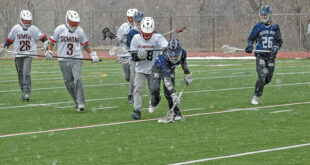“Why not?”
by Than Acuff
Pat O’Neill has started all 19 Grand Traverse races, finished 18 of them (equipment malfunction knocked his team out of the 2006 race), won the overall title three times, the coed title once and finished on the podium 11 times. He first heard about the Grand Traverse idea while on a bike ride on trail 400 just below Star Pass the summer of 1997.
“Jan Runge was out hiking with Brian Dale and Jerry Deverell and saw me riding my bike and Jan grabbed my handlebars and asked me what I thought about a ski race where no one has raced before,” says O’Neill. “I said, ‘That would rock.’”
Runge, who was the original race director, asked O’Neill and his friend and traverse partner for several years, Jimmy Faust, to ski the course during the winter of 1997/1998 to give race organizers an idea of how long it would take and the inaugural Elk Mountains Grand Traverse race was held on April 3, 1998 and billed as an “extreme endurance backcountry skiing race.”
The race has come a long way since its inception in 1998. Fifty teams lined up at midnight on the town ranch for the inaugural Elk Mountains Grand Traverse, carrying huge packs and running everything from Kazama skis and Merrill Supercomps boots to a full Nordic set-up. This year close to 220 teams will be lining up at the base of Crested Butte Mountain Resort for the Gore Tex Grand Traverse presented by Dynafit and Outdoor Research, with a majority of them wearing the latest and greatest in lightweight alpine touring gear with packs barely bigger than a kid’s school backpack but still full of the mandatory gear.
“There were leather boots, telemark skis, scaled skis with edges and a lot of Nordic set-ups,” recalls O’Neill of the beginning years. “The hot ski was the Fischer Superlight and the boot was a Salomon Combi.”
Around the ninth or tenth year of the race, equipment really started to change to what is now the common gear of the Grand Traverse race.
“2007 is when we started to see skimo gear but there was still more Nordic then,” says O’Neill. “2007 to 2009 were the three transition years.”
Twenty years ago teams carried an assortment of food, mostly of the sandwich variety, looking for simple sustenance during the long race. That idea, at least for the perennial leaders, was abandoned during that first race.
“That first year we both had two meatloaf sandwiches but Pierre Wille and Travis Moore smoked the field so hard we didn’t get to eat anything,” says O’Neill. “We basically just carried the sandwiches to Aspen.”
Now, many teams run off of water or electrolyte-replenishing drinks and a variety of power foods such as gels, Gus and whatever happens to be the latest in endurance-athlete–specific foods.
As for conditions, O’Neill has seen it all and watched teams crumble under the stress of mountain weather and backcountry conditions.
“Over the first 19 years we’ve had so many different nights in terms of weather,” says O’Neill. “It’s been too warm, too cold, too snowy, no snow. In 2012 Marshall and I pretty much ran almost all the way to the Friends Hut. In 2009 we probably saw the most intense blizzard I’ve ever seen in my life. Teams folded. It was really intense.”
One of the most lucid of O’Neill’s memories of course conditions comes from the race in 2013, when teams were met with unseasonably warm temperatures.
“The snow hadn’t frozen on the hillside above Trampe’s, and skiers had taken their skis off and were climbing up out of this ravine post-holing to their waists,” describes O’Neill. “It was a full-on zombie apocalypse. It was the most disturbing thing I’ve ever seen, and I’ve seen that guy trying to eat the nachos at a Grateful Dead show.”
According to O’Neill, the difference between finishing and not finishing the race comes down to several factors.
“The course is a man-eater,” says O’Neill. “There’s a variety of factors—darkness, for one. A lot of things can go wrong and some people get too caught up in the race aspect and blow themselves up. It’s still a team race so it’s crucial that they work together as a team. Team members have blown each other up. I’ve been blown up by every person I’ve skied it with.”
As to whether or not the Grand Traverse is just another skimo race, O’Neill feels otherwise.
“I don’t see it as a skimo race,” says O’Neill. “The Koons brothers took third last year on Nordic gear. In 2008 or 2009 Mike Kloser and his partner rolled the dice and did it on Nordic gear and won. The race is never the same. People are changing strategies constantly so I wouldn’t call it a skimo race. I’m all about Nordic skis, splitboards, pogo sticks, whatever.”
After the three overall titles and 11 podiums over 19 years, O’Neill has a handful of reasons why he keeps doing it.
“Why not?” says O’Neill. “It’s the 20th year for Team Alpineer and that store has allowed me to do the race every year. I want to see Al Hadley finish 20—that’s my reason to do it this year. It’s still amazing to me that an event where people are skiing through the middle of the night still fills up in four to five hours. It has some mystique to it.”
You can hear more stories from O’Neill and other past racers and volunteers at the Grand Traverse Legends Night on Thursday, March 23 at the Mallardi Cabaret Theatre starting at 7 p.m.
 The Crested Butte News Serving the Gunnison Valley since 1999
The Crested Butte News Serving the Gunnison Valley since 1999



